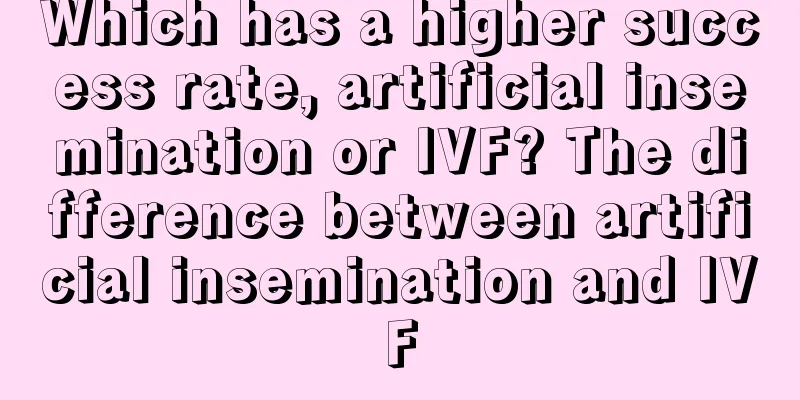Which has a higher success rate, artificial insemination or IVF? The difference between artificial insemination and IVF

|
Artificial insemination and IVF are both advanced medical technologies that help women become pregnant successfully. Which one has a higher success rate? What are the differences between artificial insemination and IVF? If you don't know yet, follow the editor to find out~ Which has a higher success rate, artificial insemination or IVF?What is the success rate of artificial insemination? Successful intrauterine artificial insemination often requires 3-5 cycles. It is generally believed that after 6-8 cycles of intrauterine artificial insemination, artificial insemination should be abandoned for in vitro fertilization. The pregnancy success rate of intrauterine artificial insemination per cycle is about 10%-20%. After more than 3 cycles of continuous treatment, the pregnancy rate can reach 40%. According to observations and statistics, the success rate of artificial insemination between non-spouses is higher than that between spouses. What is the success rate of IVF? If you have sex around the peak fertility period, 75% of women will conceive within 2.76 menstrual cycles, so we can roughly calculate that the average monthly success rate of pregnancy for couples without fertility problems is 27%. The normal frequency of sexual intercourse for young couples is once every three or four days. In theory, such a frequency can make couples without fertility problems conceive successfully on the scheduled day, but the actual success rate is much lower. Therefore, the success rate of IVF is higher than that of artificial insemination. However, the cost of IVF is relatively higher than that of artificial insemination. The cost of IVF is between 20,000 and 30,000 yuan. The cost of artificial insemination is about 4,000 yuan. Another difference is that IVF is in vitro fertilization, while artificial insemination is still in vivo fertilization. The two methods are also suitable for different groups of people. Artificial insemination: Only when the fallopian tubes are unobstructed can it be doneArtificial insemination (IUI) is a process in which the male's semen is washed and optimized in the reproductive center laboratory, and the sperm with the best mobility is selected. The sperm is then delivered to the female's uterine cavity through an injection device, allowing the sperm and egg to combine naturally in the female's body. The prerequisites for artificial insemination include sufficient active sperm in the male's ejaculated semen, at least one of the female's fallopian tubes is unobstructed and the ovary on that side ovulates normally, and the female's uterus is normal or has abnormalities that do not affect the artificial insemination operation and fetal development. Artificial insemination can be done if the following eight conditions exist: Mild to moderate male sperm or semen abnormalities, such as oligoasthenozoospermia, teratozoospermia, long semen liquefaction time or no liquefaction; The male has sexual dysfunction, which means that he can ejaculate outside the body but cannot ejaculate into the female's vagina, such as hypospadias, retrograde ejaculation, erectile dysfunction, premature ejaculation, and difficulty ejaculating during sexual intercourse; The woman has vaginismus or anatomical abnormalities, which prevent semen from entering the vagina; The female's cervical factors hinder the sperm from entering the uterus, such as cervical stenosis, thick cervical mucus, etc. Ovulation disorder in the female partner; The female partner has mild to moderate endometriosis; Immune factors, such as positive anti-sperm antibodies in male semen and positive anti-sperm antibodies in female cervical mucus; Unexplained infertility. If three attempts at artificial insemination have failed, the first generation of in vitro fertilization (IVF-ET) is generally necessary. Of course, some people can continue to try artificial insemination a few more times. IVF"Test-tube baby" is not a baby that really grows in a test tube, but a common name for in vitro fertilization and embryo transfer technology. The process is to take a few eggs from the woman's ovaries, combine them with the man's sperm in the laboratory to form embryos, and then transfer the embryos to the woman's uterus to implant and conceive. The first generation of IVF technology The first generation of IVF technology, namely conventional IVF technology (IVF-ET), is to take out the woman's eggs through drug-induced ovulation and egg retrieval surgery, put them into the optimally treated semen, and then fertilize them in a culture dish and develop them into embryos. Then, high-quality embryos are selected and transplanted back into the woman's uterus to allow them to implant and develop. This technology only provides a platform for sperm and eggs to combine well, and doctors do not directly intervene in which sperm combines with eggs. Suitable for: Female infertility due to fallopian tube factors, such as blocked fallopian tubes caused by tubal ligation or inflammation. Second generation IVF technology The second generation of IVF technology, namely intracytoplasmic sperm injection (ICSI), is that under a microscope, the doctor injects a single sperm directly into the egg cytoplasm to fertilize it. That is, this sperm must rely on human help to combine with the egg. The so-called second-generation test-tube baby technology, namely intracytoplasmic sperm injection (ICSI), is that under a microscope, the doctor directly injects a single sperm into the egg cytoplasm for fertilization. That is, this sperm must rely on human help to combine with the egg. It is mainly suitable for severe male infertility, such as severe oligospermia, asthenozoospermia, teratozoospermia, severe sperm acrosome abnormalities, and azoospermia patients who can obtain mature sperm through testicular or epididymal sperm retrieval. How to improve sperm quality The third generation of test tube baby technology The so-called third-generation IVF technology, namely preimplantation genetic diagnosis (PGD), is to obtain embryos through the above IVF technology, perform genetic diagnosis on the embryos, select healthy embryos and then transplant them back into the uterus. It is mainly suitable for genetic diseases such as chromosome translocation and thalassemia. Artificial insemination and IVF, how much does it costThe success rate and cost of different assisted reproductive technologies are different. The pregnancy rate of artificial insemination (i.e. the percentage of women getting pregnant) is 12.48%, the pregnancy rate of conventional IVF is 47.32%, the pregnancy rate of intracytoplasmic sperm injection (ICSI) is 46.23%, and the pregnancy rate of preimplantation genetic diagnosis (PGD) is 37.16%. Rapid conception and promoting ovulation are the key! Including the cost of examination and treatment, the cost of artificial insemination is about 3,000 to 5,000 yuan each time, the cost of conventional IVF and intracytoplasmic sperm injection (ICSI) is about 25,000 to 30,000 yuan, and the cost of preimplantation genetic diagnosis (PGD) is about 38,000 to 50,000 yuan. Of course, the specific cost will vary depending on the condition of each person. The difference between artificial insemination and IVFArtificial insemination is a method of artificially injecting male semen into the female cervix or uterine cavity to assist conception. It is mainly used for male infertility. There are two types of artificial insemination: artificial insemination between spouses and artificial insemination between non-spouses. Who is suitable for artificial insemination? First of all, at least one side of the fallopian tube must be unobstructed, and artificial insemination is only suitable when the unobstructed ovary is ovulating. Artificial insemination is actually to select sperm and inject it into your uterine cavity, and then ovulate through B-ultrasound. After ovulation, sperm will be injected into you according to the ovulation situation. However, this requires the fallopian tube fimbria to naturally catch the egg, and it must be able to enter the fallopian tube, that is, the egg must be able to enter the fallopian tube naturally, and it may meet the sperm. If the conditions of the fallopian tube are not good, the sperm and egg cannot meet. In vitro fertilization is a series of techniques that use reproductive assisted technology to manipulate sperm, eggs and embryos in vitro and then send them into the human body to help infertile couples have children. It includes artificial insemination, fallopian tube gamete transfer and in vitro fertilization-embryo transfer. The pregnancy process of in vitro fertilization is the same as that of normal pregnancy. To do IVF, first of all, you must have a blocked fallopian tube on both sides, or a person with a bad pelvic environment. It is precisely because the fallopian tube is blocked, and the fallopian tube is the channel for the combination of sperm and egg. It is precisely because this channel is blocked that the sperm and egg cannot meet. Only the female's egg is taken out, and then the male's sperm is taken out, and combined in vitro. In vitro fertilization is actually the process of sperm and egg combination completed in the laboratory, but once the sperm and egg are combined, to form a fertilized egg, the formation process of the fertilized egg is actually put together on the first day, and when you look at it again on the second day, it is a two-cell, and when you look at it on the third day, it is a four-cell, which is a multiple growth. Under normal circumstances, it will be implanted into the uterine cavity when it is eight cells. Therefore, the success rate of IVF depends on many factors. One is whether the treatment of the egg itself is good, the quality of the impregnation is good, the quality of the sperm and egg combination is very good, and the environment of the uterus after implantation is good. It can be seen that there is a big difference between artificial insemination and in vitro fertilization. |
<<: Is IVF sexual or asexual? Can IVF lead to ectopic pregnancy?
Recommend
Can I brush my teeth during the confinement period? How to brush my teeth correctly during the confinement period?
The confinement period is the most critical perio...
How to cook salmon for babies? This is the right way to feed your baby
Salmon is a very nutritious fish, and many mother...
What are some good sleep songs for babies?
What should I do if my baby has trouble falling a...
Can salt be added to baby food for seven months? At what age can babies eat salt?
Complementary food refers to the food that babies...
How to deal with baby's intestinal gas? Quick solution: physical and drug treatment
As adults, I believe you have all experienced the...
Why are babies particularly sensitive? Four characteristics of highly sensitive children
The issue of skin sensitivity has always been a f...
How is the Zhenshiming steam eye mask? How to use the Zhenshiming steam eye mask
Using a steam eye mask before going to bed can ef...
What should pregnant women prepare for hospitalization before delivery?
Pregnant women need to be well prepared to be adm...
Can you still drink moldy tea? How to deal with moldy tea?
If you find that the tea leaves stored at home ar...
Is Liby laundry detergent good? How much does a barrel of Liby laundry detergent cost?
Liby is also an old brand that we are very famili...
What are the specific steps of the LeBoyet method? What are the benefits of the LeBoyet method?
During childbirth, shifting the focus to the baby...
Can a newborn baby sleep on his stomach? Why does a newborn baby always spit bubbles from his mouth when sleeping?
Mothers should all have discovered that their bab...
What is the cause of the baby's fever and convulsions? How to treat it?
When a baby has a fever and convulsions, it is in...
Can I have sex during the pregnancy preparation period? How often should I have sex during the pregnancy preparation period?
Since you are preparing to be a father or mother,...
How long should infant rice cereal be eaten? When should infant rice cereal be added?
In our daily life, we often see mothers feeding t...









